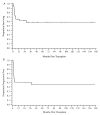Long-term survival in patients with peripheral T-cell non-Hodgkin lymphomas after allogeneic hematopoietic stem cell transplant
- PMID: 22136377
- PMCID: PMC4054938
- DOI: 10.3109/10428194.2011.645818
Long-term survival in patients with peripheral T-cell non-Hodgkin lymphomas after allogeneic hematopoietic stem cell transplant
Abstract
Peripheral T-cell non-Hodgkin lymphomas (T-NHL) are rare diseases, with a worse prognosis compared to their B-cell counterparts. Allogeneic hematopoietic stem cell transplant may have a role in the treatment of relapsed/refractory disease or high-risk histologies in the upfront setting. However, there is limited information on the efficacy of allogeneic transplant for these diseases, as well as what factors may predict outcomes. We therefore performed a retrospective study of 34 patients who received an allogeneic transplant for the treatment of T-NHL at a single center between 1 January 1992 and 31 December 2009. The median follow-up for survivors was 45 months (range 9-160 months). The 2-year overall survival (OS) was 0.61 (95% confidence interval [CI]: 0.43-0.75) with a plateau at 28 months. Ki-67 expression ≤ 25% was predictive of improved OS (p < 0.01), and transplant in complete remission was predictive of a decreased cumulative incidence of events (p = 0.04). Three patients received a donor leukocyte infusion, and two patients demonstrated a response, supporting a graft-versus-lymphoma effect. These data demonstrate that allogeneic transplant is a viable option for the treatment of T-NHL and merits prospective evaluation.
Figures
Similar articles
-
Unrelated donor hematopoietic cell transplantation for non-hodgkin lymphoma: long-term outcomes.Biol Blood Marrow Transplant. 2009 May;15(5):554-63. doi: 10.1016/j.bbmt.2009.01.012. Epub 2009 Mar 9. Biol Blood Marrow Transplant. 2009. PMID: 19361747 Free PMC article.
-
Ten-year follow-up of pediatric patients with non-Hodgkin lymphoma treated with allogeneic or autologous stem cell transplantation.Pediatr Blood Cancer. 2013 Dec;60(12):2018-24. doi: 10.1002/pbc.24722. Epub 2013 Aug 30. Pediatr Blood Cancer. 2013. PMID: 24038967
-
Allogeneic hematopoietic cell transplant for peripheral T-cell non-Hodgkin lymphoma results in long-term disease control.Leuk Lymphoma. 2011 Aug;52(8):1463-73. doi: 10.3109/10428194.2011.574754. Epub 2011 Jun 24. Leuk Lymphoma. 2011. PMID: 21699453 Free PMC article.
-
Controversies in autologous and allogeneic hematopoietic cell transplantation in peripheral T/NK-cell lymphomas.Best Pract Res Clin Haematol. 2013 Mar;26(1):89-99. doi: 10.1016/j.beha.2013.04.008. Epub 2013 May 25. Best Pract Res Clin Haematol. 2013. PMID: 23768643 Review.
-
Hematopoietic Cell Transplantation and Adoptive Cell Therapy in Peripheral T Cell Lymphoma.Curr Hematol Malig Rep. 2020 Aug;15(4):316-332. doi: 10.1007/s11899-020-00590-5. Curr Hematol Malig Rep. 2020. PMID: 32529515 Free PMC article. Review.
Cited by
-
How I treat the peripheral T-cell lymphomas.Blood. 2014 Apr 24;123(17):2636-44. doi: 10.1182/blood-2013-12-516245. Epub 2014 Mar 10. Blood. 2014. PMID: 24615779 Free PMC article. Review.
-
Allogeneic stem cell transplantation for peripheral T cell lymphomas: a retrospective study in 285 patients from the Société Francophone de Greffe de Moelle et de Thérapie Cellulaire (SFGM-TC).J Hematol Oncol. 2020 May 19;13(1):56. doi: 10.1186/s13045-020-00892-4. J Hematol Oncol. 2020. PMID: 32429979 Free PMC article.
-
Effect of immune modulation in relapsed peripheral T-cell lymphomas after post-allogeneic stem cell transplantation: a study by the Société Française de Greffe de Moelle et de Thérapie Cellulaire (SFGM-TC).Bone Marrow Transplant. 2016 Mar;51(3):358-64. doi: 10.1038/bmt.2015.280. Epub 2015 Nov 23. Bone Marrow Transplant. 2016. PMID: 26595076 Clinical Trial.
-
Single agents vs combination chemotherapy in relapsed and refractory peripheral T-cell lymphoma: Results from the comprehensive oncology measures for peripheral T-cell lymphoma treatment (COMPLETE) registry.Am J Hematol. 2019 Jun;94(6):641-649. doi: 10.1002/ajh.25463. Epub 2019 Apr 9. Am J Hematol. 2019. PMID: 30896890 Free PMC article. Clinical Trial.
-
Role of Haematopoietic Stem Cell Transplantation in Peripheral T-Cell Lymphoma.Cancers (Basel). 2020 Oct 26;12(11):3125. doi: 10.3390/cancers12113125. Cancers (Basel). 2020. PMID: 33114606 Free PMC article. Review.
References
-
- Rudiger T, Weisenburger DD, Anderson JR, et al. Peripheral T-cell lymphoma (excluding anaplastic large-cell lymphoma): results from the Non-Hodgkin’s Lymphoma Classification Project. Ann Oncol. 2002;13:140–149. - PubMed
-
- Gisselbrecht C, Gaulard P, Lepage E, et al. Prognostic significance of T-cell phenotype in aggressive non-Hodgkin’s lymphomas. Groupe d’Etudes des Lymphomes de l’Adulte (GELA) Blood. 1998;92:76–82. - PubMed
-
- Savage KJ, Harris NL, Vose JM, et al. ALK− anaplastic large-cell lymphoma is clinically and immunophenotypically different from both ALK+ ALCL and peripheral T-cell lymphoma, not otherwise specified: report from the International Peripheral T-Cell Lymphoma Project. Blood. 2008;111:5496–5504. - PubMed
-
- Suzumiya J, Ohshima K, Tamura K, et al. The International Prognostic Index predicts outcome in aggressive adult T-cell leukemia/lymphoma: analysis of 126 patients from the International Peripheral T-Cell Lymphoma Project. Ann Oncol. 2009;20:715–721. - PubMed
-
- Reimer P, Rudiger T, Geissinger E, et al. Autologous stem-cell transplantation as first-line therapy in peripheral T-cell lymphomas: results of a prospective multicenter study. J Clin Oncol. 2009;27:106–113. - PubMed
Publication types
MeSH terms
Grants and funding
LinkOut - more resources
Full Text Sources


